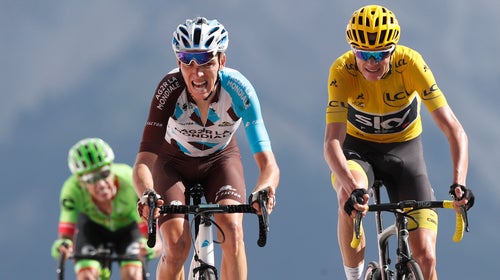Despite its long history of controversy and scandal, politics and hard-nosed business, the one thing that has always been true about the annual Tour de France is that it’s one of the toughest physical tests in all of sports. This year, the peleton will travel 3,360 kilometers, or about 2,087 miles, over three weeks in temperatures that push 90 degrees Fahrenheit. As the race winds down to its mostly ceremonial cruise through Paris, we wondered what exactly happens to Tour riders’ bodies during their push to the cork-popping.
Weight
Grand tour competitors weigh roughly between 155 and 165 pounds, according to a 2012 review of all riders, with time trial specialists typically weighing a bit more than climbers. Surprisingly, during the three weeks, racers actually retain most, if not all, of that weight. This is to their advantage, as losing weight could mean losing muscle, which means losing power. Modern teams stuff riders with calories—about 6,000 per day, according to the 2012 study. Specifically, they eat about 840 grams of carbohydrates, 200 grams of protein, and 158 grams of fat.
“Looking at the group we have at the moment, nobody has lost or gained any weight in nearly three weeks,” writes Nigel Mitchell, head of nutrition for Slipstream, which owns the Cannondale-Drapac team, via email from France. “Everybody is within a kilo and a half of how they started the race.”
In fact, some riders even gain weight early on in a tour “because of the total stressing nature of that kind of racing,” says Neal Henderson, who coaches Australian rider Rohan Dennis. Henderson explained that stress and anxiety can release stress hormones like cortisol and cause inflammation, which can lead to fluid accumulation and weight gain.
The Immune System
On Tuesday, George Bennett of New Zealand and Philippe Gilbert of Belgium both pulled out of the race due to illness, which is surprisingly common among riders. By the time they get to Paris, “I would say 30 or 40 percent of racers are sick with some type of upper respiratory tract infection,” says Allen Lim, an exercise physiologist, former consultant to Team Garmin, and founder of Skratch Labs.
While it’s well known that moderate levels of exercise can strengthen the immune system, intense exercise over periods of several weeks drives down the blood’s germ-killing lymphocyte population, depressing the immune system. The resulting state has been called “the open window” to infection.
Now throw in up to six hours of deep breathing while riding on crowded French streets (where racers inhale bits of diesel exhaust, dust, and cow dung particles), post-race handshakes, and living in close quarters with the team, and it’s almost a recipe for illness. “During the Tour,” Henderson recalled, “we used to say guys were only as strong as their guts.”
The Bones
Since cycling is a non-weight-bearing exercise, racing a grand tour is a little like living in space: Riders are working incredibly hard, but their bones are under very minimal stress. In the mid-1990s, a German team of researchers tested the bone densities of weight lifters, boxers, and Tour de France riders and compared them with age-matched controls. They found that the weight lifters and boxers had overall higher bone densities than the controls, while the cyclists’ spines were 10 percent less dense, their hips 14 percent less dense, and their Ward’s triangle, at the neck of the femur, was 17 percent less dense.
During training, riders lift weights and run to build bone mineral density. But during the Tour, they are only riding, while sweating out enormous amounts of fluids that contain bone-building minerals like potassium and calcium.
Saddle Sores
The idea that a rider could be done in by a sore butt might seem ridiculous—but it happens. When Henderson was coaching Taylor Phinney during the 2013 Giro, Phinney had such a bad sore that he had to drop out. He even contemplated surgery. While most riders have built up a tough bottom, there’s just no way to replicate the Tour. Riders put greater loads, and for much longer durations, onto the saddle and their rear ends than they do at any other point. Any slight variation—say, adjusting posture to relieve a sore back—can alter the riding position just enough to wear a sore.
Hair follicles can also become infected, which is called folliculitis. A little pimple on a bum wouldn't bother most of us, Lim said, but for a rider, “it could be devastating.”
The Mind
All races are stressful, especially for riders who make a living off the sport. But the Tour is often considered the most mentally and emotionally exhausting event in cycling because of the increased media coverage and the crowds, as well as the intensity of the race. “You have 160 people riding at 30 miles an hour, and with one touch of the brakes, bad things can happen,” says Henderson. “People can go down. Bones can break. And that level of anxiety is sustained through the entire race.”
After stage six this year, British rider Simon Yates said, “A day like this for me is not so difficult on the body. It’s more the head, the stress of fighting for position, to avoid crashes or splits in the bunch…We’re going so fast, and everything happens much quicker than you can imagine. It’s very stressful for everybody.”

